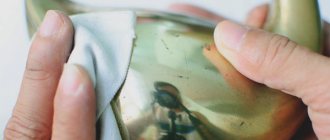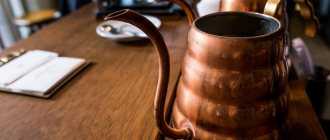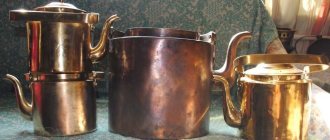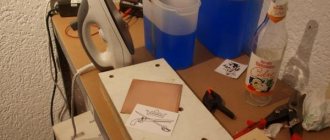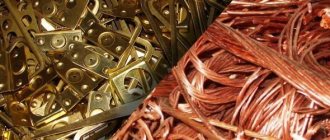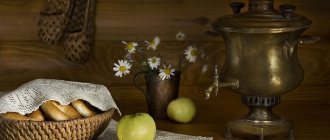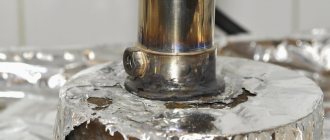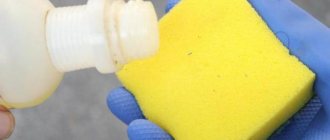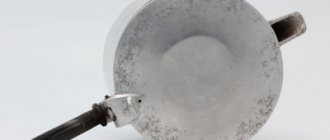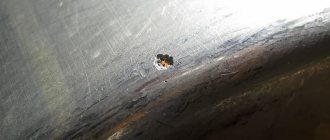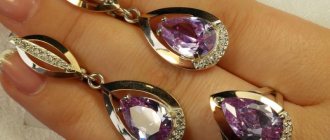Copper belongs to the category of materials that undergo corrosion when exposed to aggressive environments. As a result, material deterioration occurs, gradual destruction and loss of normal performance qualities.
In many ways, the features of the process and its dynamics may differ depending on the environment, temperature conditions and other characteristics.
Let's consider in what environments the material begins to deteriorate most quickly and how to further protect it from the rusting process.
How copper corrosion occurs in water, alkali, and acid. Protective measures.
Corrosion of copper is not as well known as the corrosive effects of iron. However, the mechanisms of influence on the metal structure are similar. This is spontaneous destruction when exposed to various types of aggressive environments. It is impossible to unequivocally compare the concept of rust with copper corrosion. Corrosion of any metal is associated with thermodynamic instability under the influence of active elements that are in the air. The rate of copper corrosion will directly depend on temperature fluctuations. If you increase it by 100 degrees, the pace increases 2-3 times. Next, we will consider how corrosion of copper alloys occurs and how to protect them from oxidation in various deployment environments.
Cleaning samovars and teapots
All methods are also suitable for cleaning copper samovars, teapots and Turks. It’s just that it’s a little more difficult to clean the inside, because limescale deposits appear there from boiling water. One proven method is to use potato peelings:
- After peeling the potatoes, leave the skins, wash them, pour them inside the dishes and pour boiling water over them.
- Boil water with potato peelings for three hours.
- Then drain the contents of the dishes and wash them in the usual way using detergent.
After such cleansing, you need to boil water in a copper bowl a couple of times, replacing it with a new one each time to remove any remaining plaque.
Another proven method is to use lemon zest. Skins from tangerines, oranges, and limes are also suitable. Then proceed like this:
- The skins are placed in the vessel, filling half the container with them. Instead of zest, you can take two packs of citric acid.
- Pour in a little water - do not fill it completely, otherwise the liquid will begin to splash out when boiling.
- Boil for half an hour, then drain the water and clean the walls of the product with a brush.
The procedure is repeated if necessary. You can also use store-bought products to descale teapots.
But detergents for washing machines and dishwashers are not suitable for copper cookware: they are more aggressive and can damage the copper surface. The selected purchased product is used strictly according to the instructions indicated on the package.
In the case of a samovar, it is recommended to disassemble it into its components before cleaning, since many different curved parts cannot be washed so easily by simple boiling.
If stains appear on copper utensils, you should not be upset; you can resort to different methods and means that give good results. It is quite easy to restore a copper surface to its former beauty.
Corrosive properties
Due to the lack of chemical activity in copper, upon contact with water or humid air, its corrosion practically does not occur. When exposed to dry air, the metal can form a small oxide film up to 50 nm thick. If the product is tinned, then almost no film is formed. A high-quality tin coating can reliably protect against moisture and temperature changes. Moreover, the service life of such an item can be up to 100 years without loss of original properties. The color will not change over time. The use of tinned surfaces has long shown its best performance. An example would be the domes of many temples.
Due to the high threshold of corrosion resistance, copper is actively used in many chemical and electrochemical industries. For example, the process of copper plating helps solve many processing problems. In one of the previous articles, we looked at the procedure at home, we recommend that you read it.
Caring for Copper Cookware
There are several rules for the care and preservation of external and internal coatings:
- store dishes only in a dry cabinet, as humidity and heat contribute to the process of destruction and blackening;
- cannot be washed in the dishwasher, even at minimum temperature;
- do not keep empty dishes on a working stove;
- To avoid scratches, it is advisable to use wooden or plastic kitchen utensils;
- abrasive detergents containing chlorine, as well as metal brushes or sponges, are prohibited;
- Copper cookware does not like sudden temperature changes, so pouring boiling water into it is not recommended;
- food containing a large amount of acids, for example: vinegar, fruits or tomatoes - it is better to put them in another container.
The healing properties of copper have long been proven, but time has not been kind to it. Therefore, only with proper storage, cleaning and care will such dishes last a long time and delight you with their incredible color and radiant shine.
Water influence
Corrosion of copper in water and the speed of the process will depend on the presence of an oxide film and the volume of oxygen dissolved in it. As a rule, an impact or point process occurs. In this case, the speed will be faster, the greater the amount of oxygen contained in the water. A liquid containing chlorine ions and a low pH level will also have a negative effect.
In general, the surface’s resistance to corrosive influences is quite high, which is facilitated by the presence of an oxide film, which does not allow the destructive element to penetrate into the metal structure. An oxide layer will form when the metal remains in water for more than 2 months. Oxide coating can be of two types:
- · Carbonate – green in color. It is considered to be the most durable.
- · Sulfate – dark in color. It has a loose structure and less strength.
The metal is often used in the production of various pipelines. However, if the liquid flowing through them comes into contact with aluminum, zinc, or iron, then it significantly accelerates their corrosion. To prevent this and protect copper from corrosion, tin plating is again carried out.
Does copper rust - Metalist's Handbook
When two dissimilar metals come into contact and an electrolyte such as moisture is present, there is a possibility of bimetallic corrosion on the more electronegative or anodic metal, as defined in the electrochemical series, which corrodes first, preventing the other metal from corroding.
The bimetallic effect is the basis for the protection that zinc coating (hot-dip galvanizing) provides to small areas of exposed steel if the coating is damaged.
Zinc coatings corrode first, protecting the metal below it in the electrochemical series.
The degree of bimetallic corrosion will depend on a number of factors such as the metals in contact, the ratio of the areas of the contacting metals and operating conditions.
Generally, the level of bimetallic corrosion will increase as the potential difference between the two metals increases, such as how far apart the two metals are in the galvanic voltage series.
However, the potential may vary due to the formation of the oxide layer and cannot be used to determine the extent of bimetallic corrosion, as other factors listed below are also important.
The area ratio of the contacting metals is essential, and ideally the anode-cathode metal ratio should be high.
If the ratio decreases, problems may arise due to high levels of oxygen reduction, which can lead to increased corrosion of the anode metal. The influencing conditions are of great importance, i.e.
Because for bimetallic corrosion, the electrolyte must bind the two existing metals.
As a result, in dry environments (indoors) the likelihood of bimetallic corrosion is very low, while in outdoor atmospheric conditions the likelihood increases due to the presence of moisture in the form of rain and condensation. The worst conditions are immersion in a solution where the electrolyte permanently bonds the two metals. Typically, any possibility of bimetallic corrosion can be mitigated by electrically isolating the two metals from each other.
For bolted connections, connections can be achieved by using neoprene or plastic washers, while for overlapped surfaces this can be achieved by using plastic spacers or painting one of the surfaces with a suitable paint coating system.
Generally, hot-dip galvanized steel performs well in contact with most common structural metals when exposed to atmospheric conditions, providing a high galvanized steel to other metal area ratio. Conversely, under immersion conditions the effect of bimetallic corrosion is greatly increased and insulation is usually required.
Copper and brass
If the installation requires contact between galvanized materials and copper or brass in a damp or humid environment, rapid corrosion of the zinc may occur. Even wastewater can contain enough dissolved copper to cause rapid corrosion.
If the use of copper or brass in contact with galvanized coatings is unavoidable, precautions must be taken to prevent electrical contact between the two metals.
The connector surface must be insulated with non-conductive pads; connections must be made with insulating fasteners and a sealing sleeve.
This is to ensure that the water does not re-spread and the flow of water from the galvanized surface to the copper or brass is not reversed.
Aluminum and stainless steel
In moderate atmospheric conditions of moderate humidity, contact between a galvanized surface and aluminum or stainless steel is unlikely to cause significant incremental corrosion. However, in very humid conditions, the galvanized surface may require electrical insulation from aluminum or stainless steel.
Stainless steel
When galvanized bolts are used on stainless steel, the zinc is initially sacrificed until a protective layer of rust develops on the stainless steel.
Once this layer of rust develops, it forms a layer of insulation that prevents the zinc from being further protected. The zinc coating must be thick enough to provide rust protection for several years.
Hot galvanized bolts have enough zinc coating to prolong the protection with minimal loss of coating serviceability.
Metal Atmospheric exposure Submerged conditionRural areas Industrial/urban areas Coastal zone Fresh water Sea water Aluminum a a-b a-b b b-c Brass b b a-c b-c c-g Bronze b b b-c b-c c-g Cast iron b b b-c b-c c-d Copper b b-c b-c b-c c-g Lead a a-c a-b a-c a-c
Stainless steel a-b a-b a-b b b-c
a - The zinc coating will experience either additional corrosion or only minor corrosion. additional corrosion, which is usually allowed during operation.
B - The zinc coating will experience minor to moderate additional corrosion, which may be acceptable in some applications.
B - The zinc coating will experience severe additional corrosion and protective measures are required.
Effect of acid and alkali
Corrosion of copper in acidic environments is less detected. The effect of nitric and sulfuric acid will be the strongest. If you place it in a concentrate of these acids, it can completely dissolve. These features are taken into account when choosing alloys for elements and pipelines in the oil and gas industry.
In an alkaline environment, the effect is not observed at all, since alkali allows copper to be reduced from a 2-valent to a 1-valent state. It is worth remembering that it itself is an alkali metal.
Protection against oxidation and corrosion under the influence of acids is carried out by inhibitors - substances that slow down the chemical reaction. The following types can be distinguished:
- · Shielding – form protective lashes and exclude the possibility of contact with acids.
- · Oxidative – the formation of an oxide occurs, which reacts with acids, thereby preventing their penetration into the metal structure.
- · Cathode – designed to increase the overvoltage of the cathodes of the solution, due to which chemical reactions reduce their intensity.
As a rule, corrosion of copper in acidic environments is prevented by shielding type inhibitors. The most common is benzotriazole, which, together with copper salt formations, forms a protective shell, slowing down the rate of corrosion or almost completely stopping it.
Clean a copper basin at home
As a rule, a copper basin is used to make jam. Such dishes have good thermal conductivity, antiseptic properties, are safe for humans, and when cooking the jam practically does not stick to the walls.
If the jam is still burnt, the copper basin can be cleaned with vinegar dough. For this ancient method, you need to knead the dough by mixing flour and table vinegar. Next, the dough is rolled out thinly and placed on the dirt.
After the mixture dries, carefully remove it. The vinegar paste absorbs dirt, making the surface perfectly clean.
Exposure to soil and moist air
Corrosion of copper in the soil is mainly caused by the influence of acids contained in the soil. Compared with the effects of water, oxygen in the soil oxidizes metal elements much less. The most dangerous microorganisms in the soil are, or rather, their secretions. They are often capable of releasing hydrogen sulfide, which destroys metal. Thus, copper lying in the soil for a long time can completely decompose.
In humid air the process does not proceed rapidly. It takes a long time. In a dry climate, destructive effects may not be observed at all. This is explained by the fact that in humid air there is a high concentration of carbon dioxide, sulfides, chlorides, which cause corrosion and are destructive to the protective film.
Prolonged exposure to humid air can cause the formation of a patina layer. This is the name given to green deposits on copper. It consists of salt oxides, which are initially dark brown in color, and then the surface begins to turn green. The peculiarity of patina is that it cannot be dissolved in water and is not affected by high air humidity. It has neutral properties to copper itself, which allows it to protect the surface from the harmful effects of the environment. In addition, modern methods of creating artificial patina make it possible to use it in objects of art and during restoration.
Why do copper products need to be cleaned regularly?
Copper ladles, Turks, samovars are distinguished by a high degree of thermal conductivity, and therefore heating in them proceeds evenly, and the food will be cooked faster. This is due to the high popularity of products in everyday life. The need to clean copper items is due to their loss of visual appeal over time. Products that are exposed to air or even frequently heated begin to fade especially quickly and lose their natural color.
Corrosion of copper in the form of an oxide film (patina) is popular only at the moment where it is required to give objects a vintage appearance, antique stylization. Otherwise, it will spoil the appearance of dishes, utensils, as well as figurines and decorations. To remove oxide deposits, darkening elements and restore their original shine, you need to clean objects from time to time. Cleaning is also required in order to prevent harmful compounds from entering the food, which are present in the green and black layers.
Effective ways to clean copper
Cleaning copper items is easy and does not require expensive products. Here are the most popular techniques used at home:
Ketchup – take some tomato ketchup, apply it to the product and leave for a couple of minutes. Then rinse with clean, cool water.- Dishwashing solution – you should lather a household sponge with a simple dish soap, wipe the surface thoroughly and rinse with water. This method is best suited for items that are only slightly faded.
- Lemon – rub the copper surface with a lemon slice, and then go over it with a brush with stiff bristles and wash with water.
- Flour and vinegar - pour a small amount into a cup, add flour until you get a medium-thick dough. Lubricate the copper product with the dough, leave it until it dries, and then remove the residue. Afterwards, rub the product with a soft cloth.
- Salt and vinegar – pour 9% vinegar into a stainless steel saucepan, add a little salt and bring to a boil. The fire should be turned off, a copper object should be thrown into the solution, and not removed until the liquid has cooled. This method is suitable for very dirty surfaces.
Now let's look at how to clean copper coins.
Cleaning Copper Coins
Copper coins are antiques and will not be issued in our time. They often need to be cleaned to restore their beautiful appearance. If a copper coin has been in contact with lead, the coating on it may be yellowish. In this case, it will be perfectly cleaned with table vinegar (9%). Green plaque should be removed with a solution of citric acid (10%) or even natural lemon juice, brown ammonia or ammonium carbonate.
It should be remembered that sometimes a layer of patina helps to give coins a more vintage and noble appearance, and therefore it is not always worth removing it. Some people try to artificially age money using home methods. To do this, take a liter of distilled water, 5 grams of potassium permanganate (pharmaceutical) and 50 grams of copper sulfate. The solution should be heated without boiling, throw coins into it, and leave until the desired shade is obtained. To consolidate the effect obtained, treat the dried money with a mixture of alcohol and benzene (1 to 1). Afterwards, the coins acquire a beautiful aged appearance and can decorate any collection of antique items.
Copper corrosion
Copper corrosion is its destruction under the influence of the environment.
Copper and its alloys are widely used in many industries. This is due to the high corrosion resistance of this metal, thermal conductivity, and electrical conductivity. Copper is perfectly processed mechanically and soldered.
Significant corrosion of copper is observed in oxidizing acids, aerated solutions that contain NH 4+, CN – and other ions that can form complexes with copper.
Mechanical cleaning of copper products
This type refers to professional cleaning and involves pre-soaking in distilled water. Then it is carefully impregnated with synthetic resin to strengthen the patina and prevent scratches during further cleaning.
Craftsmen use needles, brushes with minimal rigidity, manual and mechanical scrapers with different tip shapes, as well as metalworking tools.
This process is considered very long, painstaking, requiring patience and care.
Copper corrosion in water
The corrosion rate of copper in water largely depends on the presence of oxide films on the surface.
In rapidly moving aqueous solutions and water, copper is subject to a type of destruction called impact corrosion. The rate of impact corrosion of copper is highly dependent on the amount of dissolved oxygen. If the water is highly aerated, impact corrosion of copper proceeds intensively, but if it is deoxygenated, the destruction is insignificant. Copper corrosion in aerated water increases with decreasing pH and increasing concentration of chlorine ions. The rate of copper corrosion in water depends on the climate zone. In the tropics, the rate of destruction is slightly higher.
A special feature of copper washed by sea water is that it is one of the few metals that are not susceptible to fouling by microorganisms. Copper ions are harmful to them.
Pipelines for supplying water to homes are often made from pure copper. They are reliable and last a very long time. In the presence of dissolved carbonic and other acids in water, copper gradually corrodes, and copper corrosion products stain plumbing equipment. If water passing through copper pipes comes into contact with iron, aluminum or galvanized steel, then the corrosion of these metals increases significantly. Copper ions are deposited on the surface of these metals, forming corrosive galvanic cells.
To eliminate the harmful effects of water from copper pipes on other metals, tinned copper is used. The inside of the copper pipeline is coated with tin. The tin coating must be non-porous to avoid the formation of a galvanic element (tin is a cathode in relation to copper).
Search data for your request:
Many people have copper products at home. These can be kitchen utensils, antique coins, buttons, interior items and even jewelry. Unfortunately, one of the properties of copper is oxidation upon contact with certain substances, and it can also darken over time.
How to clean copper products at home and restore their original shine and beauty? Sometimes, copper products are specially patinated to give the effect of antiquity; in other cases, this is a consequence of unintentional oxidation.
Cleaning copper products at home is possible using both special and folk remedies.
Search data for your request:
Schemes, reference books, datasheets: Discussions, articles, manuals:
Wait for the search to complete in all databases. Upon completion, a link will appear to access the found materials.
WATCH THE VIDEO ON THE TOPIC: Galileo. Experiment. Copper cleaning
Composition for protection against oxidation during heating of copper and ee alloys
Copper jewelry is valued not only for its beauty, but also is believed to have health benefits. But unlike more expensive gold items, copper jewelry requires little care to avoid oxidation.
When oxidized, copper rings and bracelets not only become coated, they also leave unsightly green stains on the skin. This happens when copper reacts with air and water to form copper carbonate.
Copper oxidation, although unsightly, is not harmful to health, but can be avoided with proper cleaning and daily care. Today, several methods are known to protect metal from rust.
Regardless of the chosen method of protection, the protection only applies. We advise you to take the drawing that you want to translate and make a reverse drawing from it through the glass.
Then coat the metal surface with an aqueous solution. In addition to the chemical etching of metals described above, there is another method of etching using a galvanic battery.
Advantages of the method Iron products to be polished are immersed for some time in a mixture consisting of 1 part sulfuric acid to 20 parts by volume of water, then the object is removed. In addition to the galvanic method, you can use the following, very simple method for coating polished steel or iron with a thin, but very durable etching is a method of reproducing designs, ornaments, inscriptions, etc. using chemical means.
I think many people have encountered the problem of hardening metal products, or rather, on the contrary, the lack of it.
For example, today it is difficult to find a good one. That beautiful malachite or bluish-green coloring that ancient bronze products possess occurred under the influence of very long exposure. Under the influence of oxygen, a beautiful black-brown layer is formed on the surface of the copper.
To speed up this process, they resort to artificial oxidation. Multi-colored mordants and dyes for brass products. Small brass items such as buttons, clasps, buckles, etc.
Welding machines Repair Cars and motorcycles Counters Security and protection Do-it-yourself crafts Brick production Paints, varnishes and inks Cosmetics and perfumes Working with wood Precious metals Ideas for business Homemade machines Working with metal Putty, grease and glue Schemes and drawings Energy Home mini-factories.
Use the site search:. For the home handyman Putty, grease and glue Paints, varnishes and inks Working with metal Working with wood Repair Mini-production Brick production Methanol production Weaving chain-link mesh Home mini-factories Homemade products Metal detectors Security and protection Welding machines Other homemade products Drag.
Auto and motorcycle Ideas for business Schemes and drawings Household meters Homemade machines. Alternative energy Auto and motorcycle Woodworking Metal detectors Drag. How to protect copper products from plaque formation. Clean your brass thoroughly with an acidic cleaner and, if necessary, a toothbrush.
There are many suitable cleaning products available in stores, but lemon juice, vinegar and even ketchup also contain enough acid for basic cleaning, and salt can be used as an abrasive to scrub away the most stubborn stains. Rinse the copper piece to remove any cleaning agent, then neutralize any remaining acid. Dip the item in a mixture of 1 part baking soda and 16 parts water. Rinse the jewelry again with clean water and dry.
Lubricate all surfaces of the product with xylon or denatured alcohol. Wait until it is completely dry. Cover the copper piece with a thin layer of wax and polish until shiny.
Jewelry wax can be purchased at a jewelry store, but car wax is also great. Before going to bed, be sure to remove all copper jewelry and dry it with a soft, clean cloth to remove sweat and oil.
After these daily treatments, your copper jewelry will require less cleaning and polishing to maintain its best appearance.
Corrosion of tinned copper
Tinned copper has excellent corrosion resistance. Tinned copper serves well even under the influence of rain, hail, snow, and is not sensitive to changes in ambient temperature. Atmospheric corrosion of tinned copper is very negligible. The tin coating is an anode in relation to copper, because has a more electronegative potential. If there are no flaws on it (pores, cracks, scratches) through which copper comes into contact with the atmosphere, it will last a very long time. If coating defects are present, atmospheric corrosion of tinned copper proceeds through the following reactions:
A: Sn – 2e→ Sn 2+ – oxidation of tin;
K: 2 H2O + O2 + 4e → 4 OH – – reduction of copper.
High-quality tin plating extends the life of tinned copper to 100 years or more.
Metal preservation methods
Almost all metals in a gaseous or liquid medium are subject to surface destruction. The main way to protect copper from corrosion is to apply a protective layer to the surface of products, consisting of:
- Metal – a layer of metal is applied to the copper surface of the product, which is more resistant to corrosion. For example, brass, zinc, chromium and nickel are used as it. In this case, contact with the environment and oxidation will occur with the metal used for the coating. If the protective layer partially deteriorates, then the base metal, copper, is destroyed.
- Non-metallic substances are inorganic coatings consisting of glassy mass, cement mortar, or organic coatings - paints, varnishes, bitumen.
- Chemical films - protection is formed chemically, creating compounds on the metal surface that reliably protect copper from corrosion. To do this, they use oxide and phosphate films or saturate the surface of the alloys with nitrogen, organic substances, or treat them with carbon, the compounds of which reliably preserve it.
In addition, an alloying component is introduced into the composition of copper alloys, which enhances the anti-corrosion properties, or the composition of the environment is changed, removing impurities from it and introducing inhibitors that slow down the reaction.
Atmospheric corrosion of copper
Under atmospheric conditions, copper is highly resistant to corrosion. In dry air, the surface of copper remains almost unchanged. And upon contact with moist air, an insoluble film is formed, consisting of copper corrosion products such as CuCO3•Cu(OH)2.
Depending on the composition of the environment and many other factors, a very thin protective film consisting of copper oxides and pure copper oxide is first formed on the copper surface in the atmosphere. The formation time of this film can reach several years. The surface darkens a little and becomes brownish. Sometimes the film can be almost black (largely depends on the composition of the corrosive environment). After the formation of the oxide layer, copper salts with a greenish tint begin to accumulate on the surface. The resulting oxide of copper and salt is also called patina. The color of the patina ranges from light brown to black and green. Depends on the quality of surface treatment, the composition of the metal itself and the environment, the time of contact with the corrosive environment (from internal and external factors). Copper oxide is red-brown in color, copper oxide is black. Blue, green, blue and other shades of patina are caused by various copper minerals (sulfates, carbonates, chlorides, etc.). Patina is neutral in relation to the base metal, i.e. does not have a harmful effect on copper (except copper chloride). Salts and oxides that form patina are insoluble in water and have natural decorative and protective properties in relation to the copper surface.
The presence of carbon dioxide in humid air leads to the formation of a mixture on the surface, which is also called malachite. Sulfides and chlorides in the air destroy malachite. This accelerates atmospheric corrosion of copper.
Effective cleaning methods
Today, the arsenal of tools that can be used to clean copper has expanded significantly. Together with ancient vinegar, sand and wire sponges, a large number of both specially designed products and those adapted by folk craftsmen are used. Among the latter there are some quite unexpected ones.
How to clean copper
- Tomato ketchup. Apply a small amount of tasty seasoning to the stain and leave for several minutes. Rinse off with plenty of water.
- In case of light stains, you can try washing them with a regular gel detergent. The gel is squeezed onto a soft sponge and then applied to a copper object. After leaving for a minute, rub the surface and rinse with water.
- Used for large products, such as a samovar. Cut the lemon in half and rub the half over the surface of the product. Next, clean with an elastic fluffy brush and rinse with water.
- Vinegar dough. Mix vinegar and regular table flour in equal parts. Stir until a homogeneous paste-like mass is obtained. Next, the paste is spread in a thin layer on the surface to be cleaned. After waiting for complete drying, remove the product with a rag or wooden spatula. The product must then be polished with a soft cloth.
If the above methods do not lead to success, use the following method:
- Prepare a stainless steel basin or pan.
- Pour vinegar and add a couple of tablespoons of regular table salt. Stir thoroughly.
- Immerse the item to be cleaned in the solution and bring to a boil.
- Remove from heat and leave to cool at room temperature.
- Drain the cooled solution, rinse the copper object and wipe dry.
Cleaning copper with vinegar
If you decide to clean copper, take precautions. The use of protective gloves and glasses is mandatory. If you dilute vinegar essence, you should ensure ventilation of the room.
This is interesting: Brass LS59-1: characteristics and composition of the alloy, GOST
Copper corrosion in soil
Copper corrosion in soil is highly dependent on the pH value of the soil. The more alkaline or acidic the soil, the faster the corrosion of copper in the soil occurs. Aeration and soil moisture have a less strong influence. When the soil is highly saturated with microorganisms, the corrosion of copper and its alloys increases. This is explained by the fact that some of them, in the course of their life, produce hydrogen sulfide, which destroys the protective oxide film.
The products of soil corrosion of copper and its alloys are more complex in composition than those resulting from atmospheric corrosion and have a layered structure.
If a copper product lay in the soil for a very long time, it could completely turn into a loose light green mass consisting of copper corrosion products. If the product remains in the soil for a short time, only a small layer of patina can be observed, which can be easily removed mechanically.
Useful tips and tricks
It is worth adhering to the following recommendations to maintain the shine of copper products for a long time:
- To preserve the natural copper shine of objects for a long time, you can use a protective varnish coating. For example, cheap copper jewelry can be coated with clear nail polish. This method allows you to isolate the product from contact with the air atmosphere and human skin, which will preserve its shine for a long time. Besides nail polish, you can also use beeswax. This product can be found in relevant stores.
- Do not use abrasives or steel objects when cleaning copper metal as they are harder than soft copper and can severely scratch the product.
- Heat and humidity are the enemies of copper cookware, as they significantly accelerate their destruction and blackening. To avoid continued exposure to these factors, store the product under appropriate conditions, such as a dry, ventilated cabinet.
- It is not recommended to cook food containing a lot of acids in copper cookware at high temperatures. Products containing acids, such as vinegar, fruits, tomatoes and others, cause serious harm to copper products.
- Most decorative items are coated with a protective varnish layer. Such items should be washed only with warm water and soap and do not use abrasive materials or polish these items, as all this can damage the protective coating. In addition, products with a protective coating require special care, so it is recommended to follow the manufacturer's instructions.
- Some copper food utensils have a protective coating that must be removed before using the utensils for their intended purpose. There are two ways to remove the coating: place the product in boiling water with a small amount of baking soda, or thoroughly wipe the product with a cotton cloth soaked in alcohol or acetone, and then rinse under running water.
- Do not forget to wipe copper products with a damp, clean cloth, not allowing dust and dirt to accumulate on them.
Home methods for cleaning black on copper products should be used from time to time as needed, but you need to understand that the items will become thinner each time.
This is interesting: Melting point of brass and bronze: melting at home
Copper is unstable in the following environments:
– sulfur, hydrogen sulfide, some other sulfur compounds;
– oxidizing acids, aerated non-oxidizing (also carbonic), hot, cold H2SO4 concentrate,
– solutions of oxidizing salts of heavy metals (Fe2(SO4)3, FeCl3);
– aerated waters, fast-moving aqueous solutions, aggressive waters (low content of magnesium and calcium ions, high content of oxygen, carbon dioxide);
– amines, NH4OH (containing oxygen).
The influence of impurities on the deterioration of metals
It is known that metals in their pure form are practically not subject to corrosion. But in practice, all materials contain some amount of impurities. How do they affect the safety of products during use? Let's assume that there is a part made of two metals. Let's consider how corrosion of copper and aluminum occurs. When exposed to air, its surface is covered with a thin film of water. It should be noted that water decomposes into hydrogen ions and hydroxide ions, and carbon dioxide dissolved in water forms carbonic acid. It turns out that copper and aluminum immersed in a solution create a galvanic cell. Moreover, aluminum is the anode, copper is the cathode (aluminum is to the left of copper in the voltage series).
Aluminum ions enter the solution, and excess electrons pass to the copper, discharging hydrogen ions at its surface. Aluminum ions and hydroxides combine and are deposited on the surface of aluminum as a white substance, causing corrosion.
Causes of copper corrosion.
Copper corrosion is the process of spontaneous destruction of this metal as a result of various types of environmental influences. Here it is impossible to apply such a concept as rusting, which is customary to describe this process with iron. The cause of corrosion of any metal is the thermodynamic instability of the material to the effects of active substances in the air. The rate of copper corrosion directly depends on temperature changes. When the temperature increases by 100 °C, the rate of reaction increases several times.
Precautions when cleaning copper
To preserve the health of people and material assets, you must strictly follow the safety rules:
- When working with chemically active substances, be sure to ensure ventilation of the room.
- Clothing and shoes should be tight and not leave any exposed skin.
- The use of protective gloves and glasses (face shield) is mandatory.
- Do not lean over containers with reagents, especially if a violent reaction occurs with the release of gaseous products and splashing.
- To avoid scratching the surface, do not clean copper products with hard wire brushes or rough abrasives.
- There is no need to keep objects in acidic solutions longer than necessary - in addition to the oxide layer, it is also possible to dissolve the product itself.
- Valuable figurines, coins and decorative items should be cleaned only with mild products. It would be a good idea to consult with experienced specialists.
Timely and regular care will allow you to maintain a beautiful appearance, true color and radiant shine for many years.
Properties of copper
Copper is a transition element with pronounced plastic properties. It has a golden color, and in the absence of an oxide film - with the addition of pink. This is the first metal that man began to use. The Latin name of the element Cuprum (ancient Aes cuprium, Aes cyprium) comes from the name of the island of Cyprus, where copper was mined in ancient times. The second name is Aes, translated from Latin as “ore” or “mine”.
- When exposed to air, the metal becomes coated with an oxide film, which gives it a distinctive red-yellow color. Copper, along with gold, osmium and cesium, has a predominantly bright color, which distinguishes them from other metals that have a silver or gray color. This metal has high thermal conductivity, and in electrical conductivity it is second only to silver.
- Copper is highly corrosive and does not react with water and dilute hydrochloric acid. It is oxidized by aqua regia, halogens, and oxygen. In air with a high moisture content, the metal oxidizes and forms copper carbonate, which makes up the top layer of patina. The process of formation of a protective oxide film in the open air is long and can last several years. As a result, the surface of the metal darkens and acquires a brownish tint. After the formation of a film, copper salts appear on the metal and have a greenish color. The oxide of copper and salt is called patina. Its color varies from brownish to green and black and depends on many external factors. Patina is neutral to copper and has protective and decorative properties.
- Having low resistivity, this metal is widely used in electrical engineering. It is used to make wire used to make electric motor windings. Sheet material is used for the manufacture of various elements of electrical devices. The presence of even a small amount of impurities in the metal significantly reduces its electrical conductivity.
- Copper is used to produce alloys. Based on it, brass, bronze, duralumin, etc. are made. Due to their high anti-corrosion characteristics, they are widely used for plating metals in order to reduce corrosive wear.
Cleaning copper from white deposits
The white coating is also an oxide film. It most often occurs on the surface of copper alloys. Its color is determined by the metals that make up the alloy. This oxide layer can be cleaned using the following methods:
- when the content of other elements in the part material is low, sulfamic acid is used. This potent chemical should be used with great care, limiting the time and area of exposure. Careful adherence to safety precautions is mandatory.
- A mixture of two tablespoons of salt per glass of whey is made. The resulting composition is rubbed onto the surface using a soft cloth. After you have finished cleaning, you must thoroughly rinse and dry the product.
- You can also clean white deposits with regular ketchup. A little seasoning is applied to the item, the acidic environment of ketchup restores its original appearance and shine. After cleaning, rinse with plenty of water and wipe dry.
- A thick layer of white plaque should be cleaned by boiling in a mixture of table salt and 9% edible vinegar. The item is boiled until the plaque dissolves, cooled slowly and washed with plenty of cold water.
- Another way to clean white plaque is a mixture of ammonia and powdered chalk. The resulting thick paste after mixing should be applied to the object and rubbed with a stiff brush. At the end of the process, wash and dry the surface.
To properly clean copper objects, you have to spend a lot of time and effort, but brightly shiny products will be pleasing to the eye.
